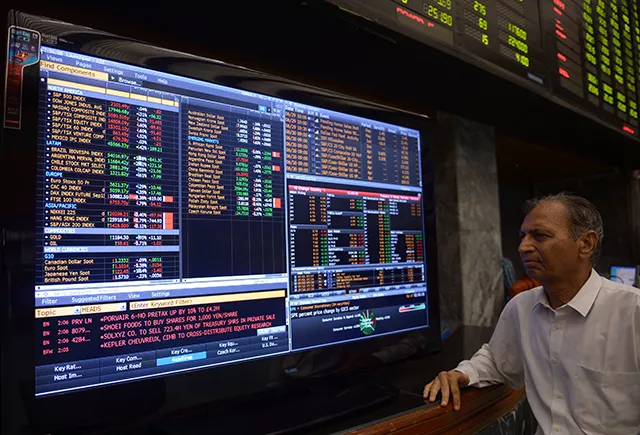The road ahead: PSX may offer 20% return in FY21
After two successive years in red, benchmark index finishes FY20 up by 1%
The underperforming Pakistan stock market, a barometer to gauge the performance of national economy, is projected to give a return on investment of around 20% in the new fiscal year starting Wednesday mainly due to a big cut in the benchmark interest rate.
“The recent cut in the benchmark interest rate is a big and an important development for the stock market,” seasoned stockbroker and Arif Habib Limited (AHL) Chairman Arif Habib said while talking to The Express Tribune.
The State Bank of Pakistan (SBP) has cut the benchmark interest rate by a significant 625 basis points in the past three months to a 25-month low at 7%.
The impact of the rate cut is yet to be fully translated into share prices of listed firms at the Pakistan Stock Exchange (PSX). “The revaluation of interest rate is yet to re-rate share prices,” he said. The rate cut made investment in stocks favourable compared to investment in fixed-income assets, he said. The rate cut would also reduce the cost of borrowing. “This will help improve financial results of listed firms,” he said.
Secondly, the Covid-19 health crisis is gradually being dealt with smartly through a smart lockdown in Pakistan. “It seems the smart lockdown is working,” he said.
The return of companies to work following the lockdown would help improve their sales revenue and profits as well. “Companies have been suffering for the last two to three months due to the lockdown imposed to contain the spread of coronavirus. Their suffering should come to an end through the recent easing of lockdown and the smart lockdown,” he said.
Important developments are expected to help the PSX’s benchmark “KSE-100 index to offer a return on investment of 20%, or post an increase of around 7,000 points to over 41,000 in FY21,” Habib said.
Fertiliser producers, oil marketing companies (OMCs) and oil and gas exploration and production (E&P) firms may lead the advance of the benchmark index in FY21. Apart from these, cement and steel firms also carried the potential to attract new investment and support the uptrend in the bourse, he said.
FY20 review
The last fiscal year, which ended on Tuesday (June 30), put brakes on the downward trend recorded in the stock market in the previous two years - FY18 and FY19.
The pharmaceutical sector outperformed the PSX. Foreign investors, however, remained net sellers for the fifth successive year in FY20, according to brokerage houses.
With an increase of 0.7% or 240 points on Tuesday, the benchmark KSE-100 index rose 1.53%, or 520 points, and closed at 34,422 points in fiscal year 2019-20.“Market capitalisation (total value of all listed firms at the PSX) closed at Rs6.5 trillion and $39 billion, down 5% and 10% respectively. As a result, PSX’s market capitalisation-to-GDP (gross domestic product) ratio fell to 15%,” Topline Securities Director Research Syed Atif Zafar said in a commentary. A review of the market performance during the year showed that KSE-100 gained 20% in 1HFY20, when the overall optimism was high about the economic recovery.
The government entered into an IMF programme in July 2019 and had also been successful in containing the fiscal and current account deficits. “The emergence of Covid-19 pandemic rocked the PSX like other financial markets and KSE-100 declined by 28% in 3QFY20. The first two cases in Pakistan were reported on February 26, 2020,” he said.
The market has since recovered as the government has eased the lockdown, with the KSE-100 index rising by 18% in 4QFY20. “The central bank’s monetary easing has also lent support to the market,” he said.
The overall activity in the bourse remained thin, though average traded volumes increased by 26% to 196 million shares per day in FY20. They were 10% lower compared to the preceding five-year average of 219 million shares per day.
The average traded value declined by 2% to $46 million per day in FY20. It also remained 51% lower compared to the preceding five-year average of $94 million per day.
Foreigners were net sellers for a fifth year in a row, with net outflow of $277 million in FY20, he said.
Individuals and insurance firms were top local net buyers during the year as falling interest rates generated greater interest in equities. Banks and mutual funds were sellers amongst the locals. Amongst different sectors, pharmaceutical and cement were key outperformers during the fiscal year, where their respective market capitalisation went up by 55% and 42%.
Oil and gas exploration, banks and power generation were key laggards with market capitalisation down 14%, 19% and 21% respectively.
“Pharmaceuticals remained in the limelight as healthcare and medical services garnered investors’ interest in the wake of Covid-19 outbreak,” he said.
The cement sector performed well as the government’s focus shifted towards construction activities to ease economic conditions of the daily wagers, for which the government also announced a construction package.
Power because of IPPs commission report, oil and gas exploration owing to fall in international oil prices and banks because of aggressive easing by the central bank, underperformed the overall market, he said.
Published in The Express Tribune, July 1st, 2020.
Like Business on Facebook, follow @TribuneBiz on Twitter to stay informed and join in the conversation.


COMMENTS
Comments are moderated and generally will be posted if they are on-topic and not abusive.
For more information, please see our Comments FAQ